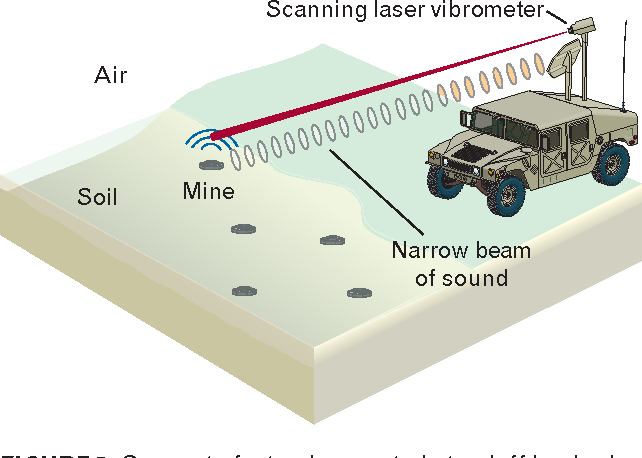Researchers develop lasers to detect landmines and underground objects
New laser vibration tech can detect buried landmines faster and safer, saving lives in over 70 countries still plagued by these hidden dangers.

A new laser vibration technology promises faster, safer landmine detection. (CREDIT: University of Mississippi)
Worldwide, an estimated 110 million landmines lie buried in over 70 countries, a deadly legacy of past and ongoing conflicts. These hidden threats caused 4,710 casualties in 2022 alone, with civilians comprising more than 85% of the victims.
Tragically, nearly half of these were children. As conflicts persist, new mines are deployed daily, deepening the humanitarian crisis. Despite their low production cost—just $3 apiece—their removal can cost up to $1,000 per mine.
Traditional methods for detecting and removing landmines are fraught with challenges. Handheld metal detectors and ground-penetrating radar are the most common tools, but they often fall short, particularly against plastic mines. Metal detectors are prone to false positives, while ground-penetrating radar can be compromised by certain soil types or environmental conditions.
This is where groundbreaking research from the University of Mississippi offers a beacon of hope. Vyacheslav Aranchuk, principal scientist at the National Center for Physical Acoustics (NCPA), has developed a cutting-edge laser vibration sensing technology. Presented recently at the Optica Laser Congress and Exhibition in Osaka, Japan, this innovation has the potential to revolutionize landmine detection.
Aranchuk’s system, known as the Laser Multi-Beam Differential Interferometric Sensor (LAMBDIS), is a significant upgrade from earlier technologies. It employs a matrix of 782 laser beams, arranged in a 34 x 23 grid, to create detailed vibration maps of the ground in less than a second. By inducing ground vibrations and analyzing how these vibrations interact with the laser beams, LAMBDIS can detect even non-metallic objects buried beneath the surface.
“Most modern mines are made of plastic, making them harder targets for traditional detection methods,” Aranchuk explained. “LAMBDIS addresses this challenge by offering precise and rapid detection from a safe distance.”
The technology is designed to be mounted on a moving vehicle, significantly accelerating the detection process while enhancing operator safety. Unlike handheld detectors, which require close proximity to potential hazards, LAMBDIS allows operators to maintain a safe distance from the detection zone.
Related Stories
Boyang Zhang, a former NCPA researcher and co-author of the report, highlighted the system’s accuracy. “Laser-acoustic detection minimizes false positives and enhances safety,” Zhang noted. “It combines laser and acoustic sensing to pinpoint landmines with greater precision, even in challenging soil conditions.”
The system works by creating a vibration image of the scanned area. Landmines and other buried objects cause unique vibrations, which appear as distinct patterns—red blobs—on the vibration map. These images are generated through the interference of light, a principle that allows the sensor to detect minute variations in ground vibrations.
“The interference of light scattered from different points on the ground reveals the vibration magnitude at each location,” Aranchuk said. This method not only improves detection accuracy but also accelerates the process, making large-scale landmine removal efforts more feasible.
While primarily designed for humanitarian and military applications, LAMBDIS has potential uses beyond landmine detection. According to Aranchuk, the technology could be adapted for structural assessments of bridges, vibration testing, and non-destructive inspections in industries such as automotive and aerospace. It may even find applications in biomedical fields.
The next phase of research will explore how LAMBDIS performs under varying soil conditions and with different types of buried objects. By refining the technology, Aranchuk and his team aim to enhance its versatility and effectiveness in diverse environments.
As global conflicts persist, the demand for efficient landmine detection technologies grows. LAMBDIS represents a crucial step forward, promising to save lives and restore safety to communities long after the fighting has ceased.
Note: Materials provided above by The Brighter Side of News. Content may be edited for style and length.
Like these kind of feel good stories? Get The Brighter Side of News' newsletter.
Joshua Shavit
Science & Technology Writer | AI and Robotics Reporter
Joshua Shavit is a Los Angeles-based science and technology writer with a passion for exploring the breakthroughs shaping the future. As a contributor to The Brighter Side of News, he focuses on positive and transformative advancements in AI, technology, physics, engineering, robotics and space science. Joshua is currently working towards a Bachelor of Science in Business Administration at the University of California, Berkeley. He combines his academic background with a talent for storytelling, making complex scientific discoveries engaging and accessible. His work highlights the innovators behind the ideas, bringing readers closer to the people driving progress.



